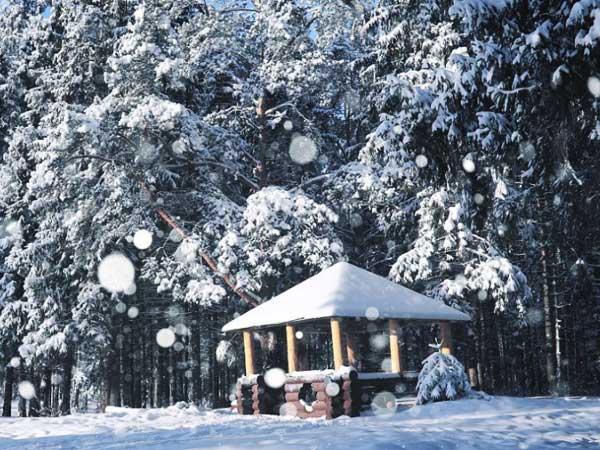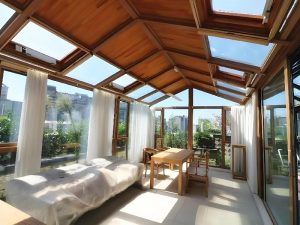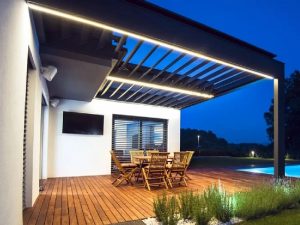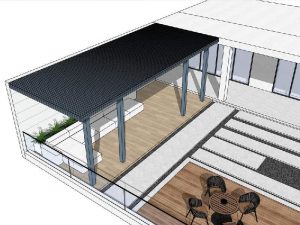It’s already September 2025, which means winter is less than three months away. Whether you’re in North America or Europe, the coming season will bring some of the harshest challenges of the year—heavy snow accumulation and powerful winter storms. If a gazebo isn’t built strong enough, it could collapse overnight under snow loads or get lifted by strong winds, causing property damage or even safety risks.
That’s why now is the perfect time to prepare for the 2025–2026 winter season. Choosing a durable, snow- and wind-resistant hardtop gazebo is not just about outdoor comfort—it’s about safety and long-term investment. A well-built structure ensures your outdoor space remains usable even in the coldest months.
In this updated 2025 guide, LIDA OUTDOOR will explain the key performance factors of hardtop gazebos—snow load capacity and wind resistance—along with frame materials, roof designs, and anchoring methods. We’ll also review several top-rated gazebos currently on the market. Whether you’re a homeowner looking for a sturdy winter-proof shelter or a distributor/wholesaler seeking reliable bulk solutions, this guide will give you clear and practical insights.
Snow Load Capacity & Wind Resistance: The Core Metrics for Gazebos
When choosing a hardtop gazebo, snow load capacity and wind resistance are the two most critical performance indicators. These metrics determine how well the structure will perform in extreme weather and directly affect its lifespan and your personal safety. If the supplier provides these parameters, always check them carefully. If not, you can still judge reliability based on the frame material, roof design, and anchoring method. Let’s take a closer look at each factor.
1. Snow Load Capacity
Snow load capacity refers to the maximum weight of snow that the gazebo roof can bear per unit area. In regions with heavy snowfall, the pressure can be surprisingly high:
- 20 psf ≈ 97 kg/m², roughly equal to a 10 cm (4 in) layer of wet snow.
- If the gazebo isn’t strong enough, the roof may collapse under this pressure, creating serious safety hazards.
That’s why choosing a gazebo with high snow load capacity is essential. It ensures structural stability during heavy snowfalls and reduces the risk of roof failure and frequent maintenance.
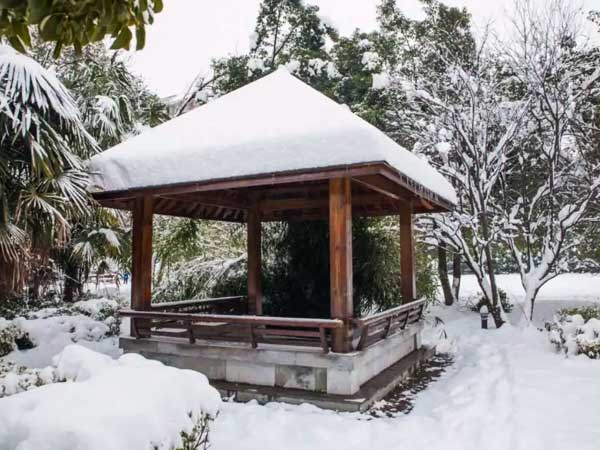
Common snow load capacity levels you can refer:
| Level | Snow Load Capacity | Suitable Scenario |
|---|---|---|
| Basic | ≤15 psf (≤73 kg/m²) | Low-snow regions, mainly for shade |
| Mid-range | 15–30 psf (73–146 kg/m²) | Temperate areas with occasional snow |
| High-strength | ≥30 psf (≥146 kg/m²) | Heavy snow regions such as Canada, Northern Europe, and Northeast Asia |
2. Wind Resistance
Wind resistance measures the maximum wind speed a gazebo can withstand. This rating depends mainly on the frame strength, structural design, and anchoring system.
- 70 mph ≈ 113 km/h is similar to a severe thunderstorm or tropical storm.
- 90 mph ≈ 145 km/h approaches the strength of a Category 3 hurricane.
A gazebo with high wind resistance can prevent shifting or collapse in strong winds, protecting both people and property.
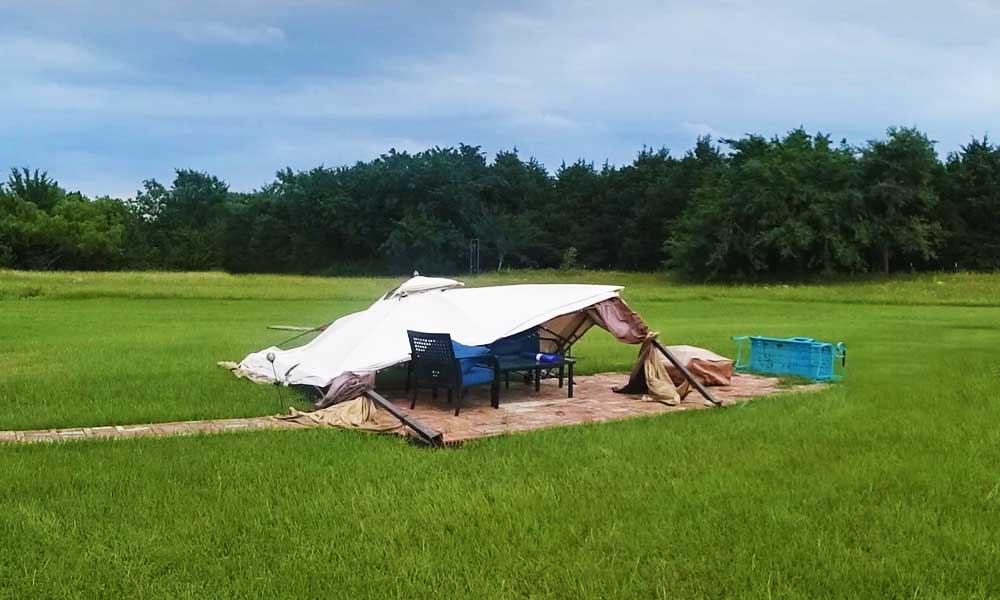
Common wind resistance levels:
| Level | Maximum Wind Speed | Suitable Scenario |
|---|---|---|
| Basic | ≤50 mph (≤80 km/h) | Calm to moderate wind areas |
| Mid-range | 60–80 mph (96–129 km/h) | Areas with frequent seasonal storms |
| High-strength | ≥90 mph (≥145 km/h) | Regions prone to hurricanes or severe windstorms |
Snow and wind ratings are only part of the story. The gazebo’s actual performance also depends heavily on its frame material, roof design, anchoring method, and overall structure—which we’ll break down in the next section.
Don’t Miss: How Much Wind Can A Gazebo Withstand?
How to Choose Hardtop Gazebos for Snow and Wind?
Among all gazebo types, hardtop gazebos generally offer the best protection against snow and wind. However, many products on the market do not explicitly list their snow load capacity or wind resistance in the specifications. This doesn’t necessarily mean they lack durability—it simply means they haven’t been officially tested. In such cases, you can judge their reliability by looking at the following key factors.
1. Frame Material: Strength is the Foundation
The frame is the backbone of the entire structure and directly determines its resistance to pressure and wind. Premium gazebos usually feature thickened, reinforced posts with larger diameters than standard models. A stronger frame means better stability against snow and wind.
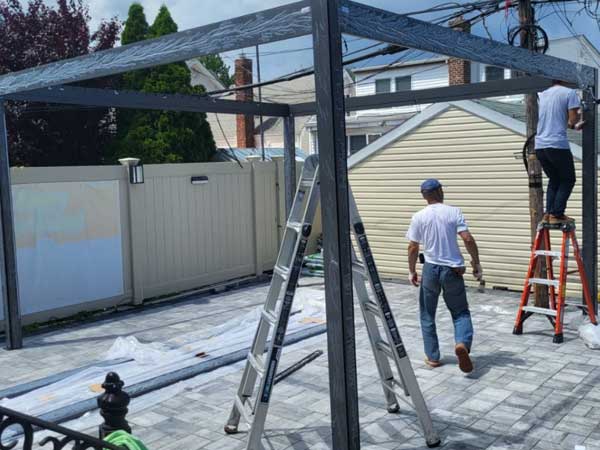
- Metal frames: Steel and aluminum are the most common. Steel provides superior strength and wind resistance, but requires anti-rust treatment. Aluminum is lightweight, corrosion-resistant, and stable for long-term use.
- Quality wood: Cedar and hardwood are naturally beautiful and strong. With proper anti-corrosion and moisture protection, they can also remain durable in snowy and windy conditions.
For more details on the advantages and disadvantages of different gazebo materials, refer to our other article, “Best Hardtop Gazebo: Material and Durability.“
2. Roof Design: Protection is the Core
The roof is the first line of defense against heavy snow and strong winds.
- Steeper slope: A steep roof slope reduces snow accumulation and helps prevent roof collapse.
- Durable materials: Common options include polycarbonate panels and steel sheets. Polycarbonate is lightweight, impact-resistant, and allows light transmission; steel roofing provides excellent load capacity and outstanding wind resistance.
Don’t Miss: 8 Types Of Material for Gazebo Roof
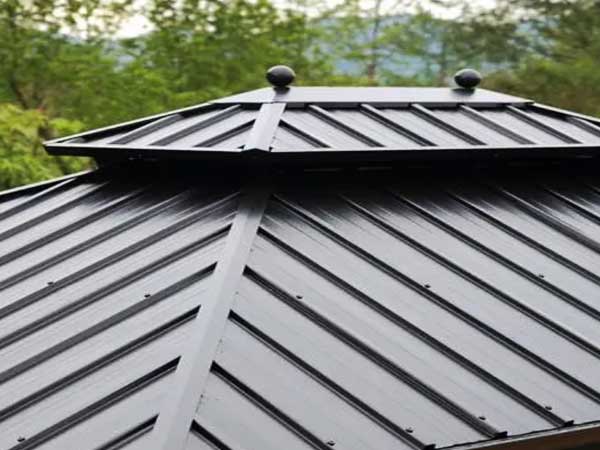
A double-vented roof not only improves ventilation but also reduces wind pressure during storms, keeping the gazebo more stable.
3. Anchoring Method: Stability Ensures Safety
Even the strongest frame won’t hold if the gazebo isn’t securely anchored. Always use the anchoring accessories provided by the supplier and follow the instructions carefully. Proper installation is essential for maximizing wind and snow resistance.
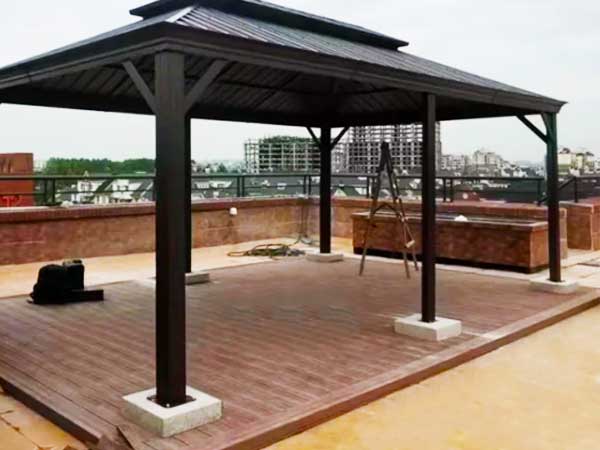
- Soft soil surfaces → Ground anchors provide better stability.
- Hard ground surfaces → A concrete foundation with expansion bolts ensures the gazebo stays firmly in place.
4. Overall Design: Details Make the Difference
A well-engineered overall design helps distribute pressure evenly and enhance durability. Features such as triangular support beams significantly improve stability, while reinforced metal connectors minimize the risk of loosening under heavy snow or strong winds. In short, a reliable gazebo is not just about the strength of individual materials—it’s about how all parts work together as a cohesive and sturdy system.
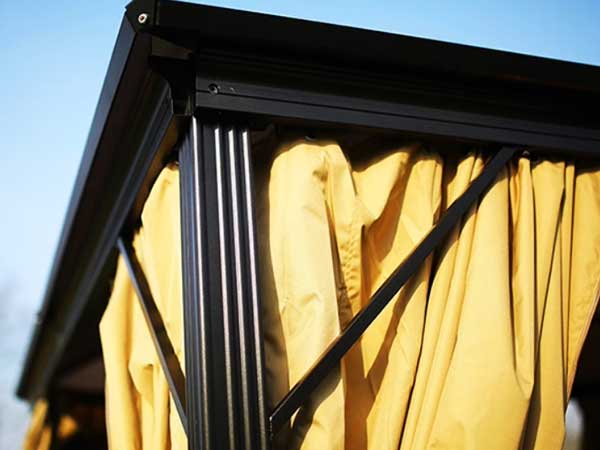
With these criteria in mind, let’s look at some of the most popular hardtop gazebos on the 2025 market and see how they perform under snow and wind.
Recommended Gazebos for Snow and Wind (Updated September 2025)
The following recommendations are based on the latest information from Amazon and the official websites of these brands (as of September 2025). We’ve selected several highly rated products to help you compare options for the upcoming winter season. If you need bulk purchasing, you can contact us. Our hardtop gazebo factory offers almost all popular metal gazebos at lower prices.
| Brand | Frame & Roof Material | Wind & Snow Performance (Tested/Reported) | Price (Sep 2025) | Best For |
|---|---|---|---|---|
| Aoxun | Aluminum frame + double polycarbonate roof |
|
$589.99 | Budget-conscious families in mild to moderate climates |
| Erommy | Powder-coated aluminum triangular frame + galvanized steel roof |
|
$669.99 | Mid-range households in normal climates, not for extreme conditions |
| Backyard Discovery | 100% cedar wood + 29-gauge galvanized steel roof |
|
$2,299 | Extreme snow/wind regions, long-term investment |
1. Aoxun Hardtop Gazebo
The Aoxun gazebo features a durable aluminum frame that resists scratching, peeling, corrosion, and rust. Its double-layer polycarbonate roof allows light transmission while blocking harmful UV rays, and features a sloped design that facilitates easy runoff of rainwater.
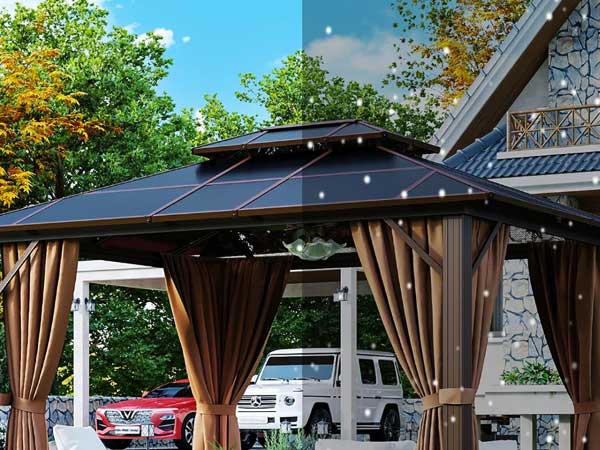
Anchoring with expansion bolts increases stability, giving it a reported wind resistance of 31–38 mph (50–60 km/h). Snow load capacity is around 4 inches, making it suitable for areas with light to moderate snowfall. The gazebo also includes removable curtains and zippered netting for added privacy and mosquito protection.
2. Erommy Hardtop Gazebo
The Erommy model features powder-coated triangular aluminum posts and a double-layer galvanized steel roof, providing a sturdy overall design. It includes pre-drilled poles, weight bags, and ropes for better stability in outdoor settings. However, no official wind or snow resistance data is provided. While the structure is reliable for general use, it is not recommended for regions with heavy snow or extreme winds.
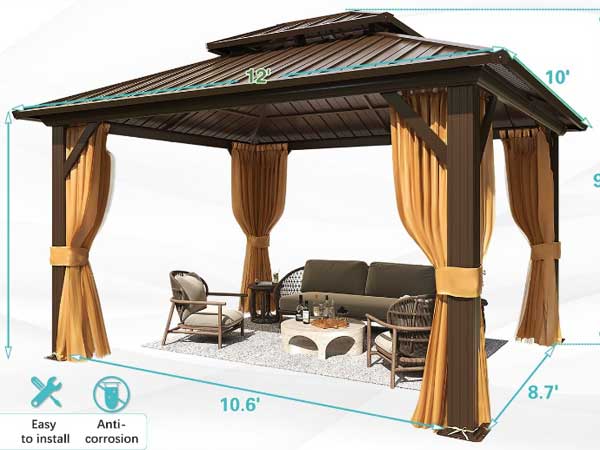
3. Backyard Discovery Hardtop Gazebo
Backyard Discovery sets itself apart with 100% cedar wood construction combined with a 29-gauge galvanized steel roof. This model is Pro-Tect certified to withstand up to 30 inches of snow (≈6,500 lbs) and winds up to 100 mph (161 km/h), making it the strongest option among the three.
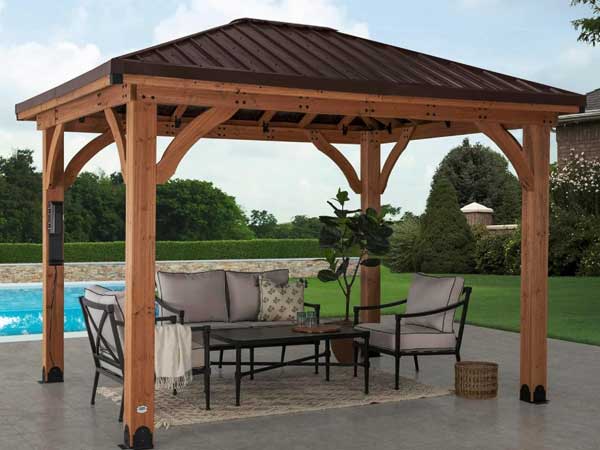
It also includes the PowerPort™ feature with three outlets and three USB ports for outdoor lighting or heating appliances. The product is backed by a 5-year industry-leading warranty, and assembly is supported by the interactive BILT 3D app. This makes it ideal for extreme climates and those seeking a long-term, durable investment.
From this comparison, it’s clear that Aoxun is the budget-friendly choice, Erommy offers mid-range durability, and Backyard Discovery is the high-end, heavy-duty option. For average households, the first two models may be sufficient depending on local climate, while those in snow-heavy or high-wind regions will benefit most from the superior strength of Backyard Discovery. For distributors or wholesalers, contacting manufacturers directly often offers more flexibility in pricing and customization options for bulk orders.
Conclusion
In short, choosing a hardtop gazebo that can truly withstand snow and wind is the key to keeping your outdoor space safe and comfortable during the winter. Before making your decision, you may want to consider:
- How harsh are the snow and wind conditions in your area?
- Are you leaning toward a short-term budget option or a long-term investment?
- Are you buying for personal use, or sourcing in bulk for distribution?
Once you’ve thought through these questions, it will be much easier to choose the right gazebo or connect with a reliable manufacturer. And if you’re looking for more cost-effective bulk purchasing options, our brand — LIDA OUTDOOR — offers a wide range of market-proven hardtop gazebos with OEM/ODM support, helping you prepare in advance for the upcoming 2025–2026 winter season. Get in touch with LIDA OUTDOOR today >

